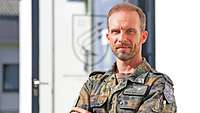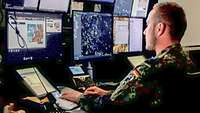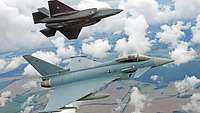JARVIS NOW CONTROLS THE WEAPONS SCHOOL’S AIR OPERATIONS
JARVIS NOW CONTROLS THE WEAPONS SCHOOL’S AIR OPERATIONS
- Date:
- Place:
- Germany
- Reading time:
- 4 MIN
JARVIS enables complex planning, management and mission control of air operations across organizational boundaries as well as direct and joint on-site analysis. The aim is to revive the face-to-face principle in high-quality training of Air Force experts for tactical air operations. In an interview, Lieutenant Colonel René Birkholz, weapons instructor and head of the tactical control unit, describes the purpose, benefits and future of JARVIS.
THE MOST IMPORTANT QUESTIONS OF THE INTERVIEW
You have always been committed to setting up a tactical control unit at the Air Force Weapons School in Laage. What kind of unit is this and why do you need it?
First of all, it wasn’t me alone. We worked together as a team consisting of the three members of the tactical operations section of the Weapons School, i.e. the other two other weapons instructors and I, plus a sergeant. But I would like to answer this question step by step.
Like the control and reporting centers of the Air Force, a tactical control unit vectors and controls the combat and support aircraft of the Air Force. In the case of our unit, however, this is not done in the context of a mission but for training and test purposes.
Why is the control unit called JARVIS?
A control unit should of course be a very intelligent system (smiles) whose software will eventually support the operators up to the point of using artificial intelligence. It made sense to give it a name that we could use to address it in the future, just as you might address your WiFi boxes at home to play your favorite song. In the Marvel Universe’s Iron Man, J.A.R.V.I.S. is the artificial intelligence of Tony Stark and the acronym stands for “Just A Rather Very Intelligent System”. For us, it is a call sign for radio communication with the pilots, just a name.
What does such a control unit look like and what happens there?
It is a rather dark hall with high ceilings, full of projectors, screens and countless ITInformationstechnik (Information Technology) systems that display an air situation picture and use radio and data links to coordinate and tactically lead the combat of air forces. In addition, we also script certain ground situations that require air support during the course of the mission. We are working with the Army here and will certainly also cooperate with the Navy in the Baltic Sea in the future to make the training of the Air Force as realistic as possible.
What’s new in the Air Force with this control unit?
At the Weapons School, we train weapons instructors for combat aircraft, combat operations, intelligence and air transport. In the future, we will also provide training for weapons instructor for anti-aircraft missiles, helicopters, unmanned aerial vehicles and other assets. Each of them must know the capabilities of the others. To carry out such integrated missions, it is essential to have a control unit directly at the site of the Weapons School which links up everyone. All ground staff come together here to observe the air situation live and all aircraft are connected via radio and data link. This platform, an air combat training installation, is now provided by our JARVIS.
What was it like in the Air Force before the Weapons School and JARVIS?
Depending on their capabilities, the Air Force trains its personnel at different locations, for example Eurofighter pilots in Laage, tactical controllers in Erndtebrück, fire control officers of the surface-to-air missile units in Husum and air transport pilots in Wunstorf. So far, they have only been able to interact in large-scale exercises and have known little about each other’s capabilities and capacities during the missions. Changing this situation was necessary. We have now created a platform at Laage where we can bring together all weapon systems and training areas, plan joint missions in theory, actively control these missions during exercises and then discuss them in person immediately afterwards.
How will JARVIS develop in the future?
With JARVIS, we are now taking the practical parts of the weapons instructor courses to a new level and bringing together the best to make them even better so that they can then take over the management of tactics and training in their units. We will then try to connect JARVIS with the Eurofighter simulator and the entire Air Force simulation network, thus bringing together live missions and real aircraft in the air with virtual aircraft in the simulators in the same mission. You can see that it remains very exciting.





